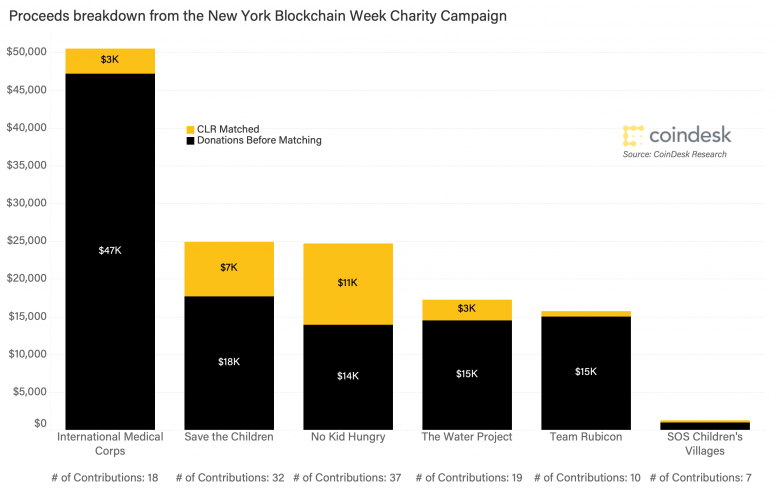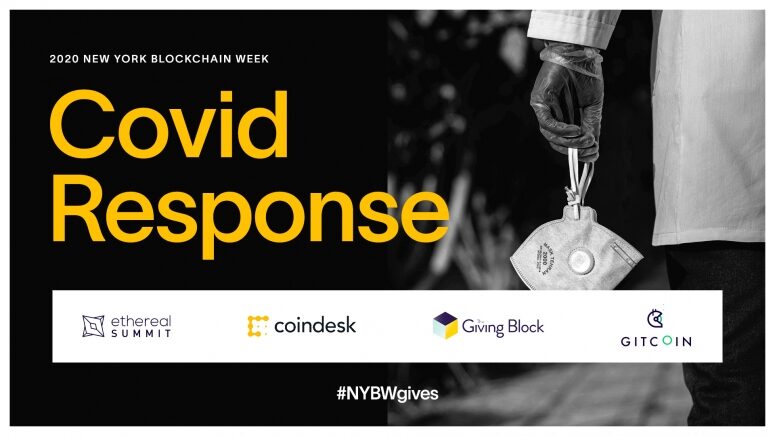When asked to dig deep for a good cause, the crypto community obliges – eventually.
On May 11, the first day of this year’s Consensus: Distributed conference and of our month-long #NYBWGives fundraising campaign for COVID-19 relief, it was a bit painful to watch the donations counter. With just a few hundred dollars clocked by 5 p.m. ET, it seemed we were never going to raise enough to match the $25,000 CoinDesk had pledged for the first of two donation-matching pools, let alone reach our $100,000 target.
But then the bitcoin and ether “whales” arrived.
Money started pouring in, sometimes in small amounts, sometimes large. Most donations were in bitcoin and ether, but we also saw a handful of bitcoin cash and litecoin donations, as well as one zcash payment. Very few were in dollars.
By the time the campaign closed, the counter showed $107,169 raised, most of it directed to the six high-profile charities our partner Gitcoin had integrated into its innovative fundraising and grant-matching platform.
(The gods then smiled on us further, as a subsequent rally in crypto prices pushed the total to $109,522 on the date our campaign partner Gitcoin locked down the data to figure out the grant distributions.)
Including CoinDesk’s matching funds, #NYBWGives will pay a total of $134,522 to six charities onboarded into the Gitcoin program: International Medical Corps, No Kid Hungry, Save the Children, SOS Children’s Villages, The Water Project and Team Rubicon.
The matching grants for these charities were decided by a mathematical formula intended to democratize matching grants. Drawing on the principles of capital-constrained liberal radicalism, or CLR, that underpin the quadratic funding concept developed by Microsoft Principal Researcher Glen Weyl and Ethereum founder Vitalik Buterin, the goal is to distribute funds to entities that receive larger numbers of smaller outside contributions.
Using the CLR model, the size of each charity’s CoinDesk grant was determined by calculating the sum of the square roots of each charity’s per-donor contributions after factoring in certain adjustments to reduce the risk of collusion.
The results were striking. The International Medical Corps’ tally of $47,225.92 in external donations, which included two large bitcoin payments of BTC 2.145 ($19,460) and BTC 1.538 ($13,952) – the two biggest single contributions in the entire funding round – was far and away the highest in dollar terms. Yet, its CLR matched funds distribution of $3,315 was considerably less than the $10,809 assigned to No Kid Hungry and the $7,194 that went to Save the Children, even though the latter two’s donation tallies stood at $13,951.34 and $17,718.8, respectively. That’s explained by a wider dispersal of contributions, with No Kid Hungry engaging 37 unique donors and Save the Children attracting 32, whereas International Medical Corps’ giant inflow came from just 18 contributors.
 A breakdown illustrating contributions and the quadratic funding contributions. Source: CoinDesk Research
A breakdown illustrating contributions and the quadratic funding contributions. Source: CoinDesk Research
In addition to that mathematically adjusted CLR Round, CoinDesk dedicated a further $25,000 to a traditional 1:1 matching pool for 11 charities, including the six already involved in the CLR round plus five more: Action Against Hunger, Operation Mask, Meals on Wheels, United Way and Doctors Without Borders. For that pool, each fund’s allocation was capped at $2,000 and any remainder was to be distributed at CoinDesk’s discretion.
The five non-CLR charities, which only received fiat donations, collected a modest $477 in total on top of the equivalent in matching funds from CoinDesk. By contrast, only one CLR-participating charity failed to reach the $2,000 cap on grants: SOS Children’s Villages, which took in contributions of $1,278.
That left $13,480 in CoinDesk matching funds at our discretion. We are applying $7,000 of that to purchase a painting by the artist Mr. Star City, who created an interpretive piece for our Consensus Happy Hour music show. Under our agreement with him, he can share half the proceeds with charity, and $3,500 of that will be evenly distributed among the 11 organizations, along with the $6,480 remaining in that pool.

The painting will be auctioned at a later date, with the proceeds also going to the same 11 charities.
We’re grateful for the hard work of our partners in this fundraising drive – Gitcoin, Ethereal and the Giving Block – and thank everyone who generously contributed to these important causes.
At a time when there are millions of people around the world whose lives have been upended by the impact of the devastating COVID-19 pandemic, CoinDesk is honored it could make at least a small difference and do so in cooperation with the crypto community we serve.
We were also excited to do this through a bold new experimental model that aligns with that community’s decentralizing ethos and addresses a crying societal need for wider inclusion in the disbursement and development of public resources. The future, not only of philanthropy but also of infrastructure development, lies in creative solutions like these by which governments and other funding entities can allocate resources in ways that amplify the widest array of voices in society.
Disclosure
The leader in blockchain news, CoinDesk is a media outlet that strives for the highest journalistic standards and abides by a strict set of editorial policies. CoinDesk is an independent operating subsidiary of Digital Currency Group, which invests in cryptocurrencies and blockchain startups.
Source
